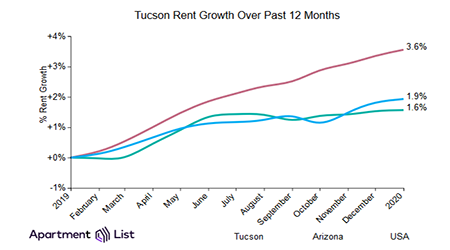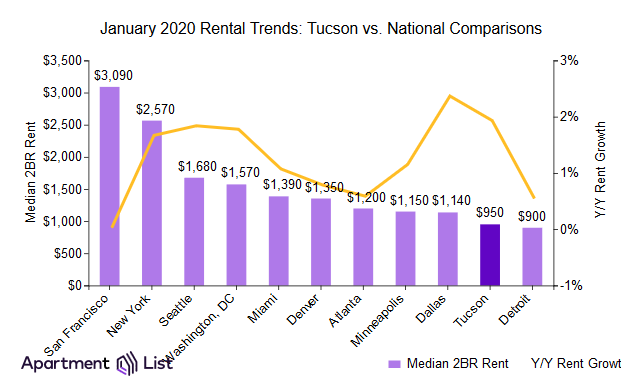February Tucson rents remained steady

Tucson rents held steady over the past month
Tucson rents have increased 0.1% over the past month, and are up slightly by 1.9% in comparison to the same time last year. Currently, median rents in Tucson stand at $716 for a one-bedroom apartment and $951 for a two-bedroom. Tucson’s year-over-year rent growth lags the state average of 3.6%, but exceeds the national average of 1.6%.
Rents rising across cities in Arizona
Throughout the past year, rent increases have been occurring not just in the city of Tucson, but across the entire state. Of the largest 10 cities that we have data for in Arizona, all of them have seen prices rise. The state as a whole logged rent growth of 3.6% over the past year. Here’s a look at how rents compare across some of the largest cities in the state.
- Looking throughout the state, Gilbert is the most expensive of all Arizona’s major cities, with a median two-bedroom rent of $1,540; of the 10 largest Arizona cities that we have data for, all have seen rents rise year-over-year, with Gilbert experiencing the fastest growth (+5.2%).
- Mesa, Chandler, and Tempe have all experienced year-over-year growth above the state average (5.1%, 5.0%, and 4.9%, respectively).

Tucson rents more affordable than many other large cities nationwide
As rents have increased slightly in Tucson, a few comparable cities nationwide have also seen rents grow modestly. Tucson is still more affordable than most similar cities across the country.
- Tucson’s median two-bedroom rent of $951 is below the national average of $1,193. Nationwide, rents have grown by 1.6% over the past year compared to the 1.9% rise in Tucson.
- While Tucson’s rents rose slightly over the past year, many cities nationwide also saw increases, including Dallas (+2.4%), Seattle (+1.8%), and DC (+1.8%).
- Renters will find more reasonable prices in Tucson than most other large cities. For example, San Francisco has a median 2BR rent of $3,090, which is more than three times the price in Tucson.
For more information check out our national report. You can also access our full data for cities and counties across the U.S. at this link.
Methodology – Recent Updates:
Data from private listing sites, including our own, tends to skew toward luxury apartments, which introduces sample bias when estimates are calculated directly from these listings. To address these limitations, we’ve recently made major updates to our methodology, which we believe have greatly improved the accuracy and reliability of our estimates.
Read more about our new methodology below, or see a more detailed post here.
Methodology:
Apartment List is committed to making our rent estimates the best and most accurate available. To do this, we start with reliable median rent statistics from the Census Bureau, then extrapolate them forward to the current month using a growth rate calculated from our listing data. In doing so, we use a same-unit analysis similar to Case-Shiller’s approach, comparing only units that are available across both time periods to provide an accurate picture of rent growth in cities across the country.
Our approach corrects for the sample bias inherent in other private sources, producing results that are much closer to statistics published by the Census Bureau and HUD. Our methodology also allows us to construct a picture of rent growth over an extended period of time, with estimates that are updated each month.
Read more about our methodology here.
